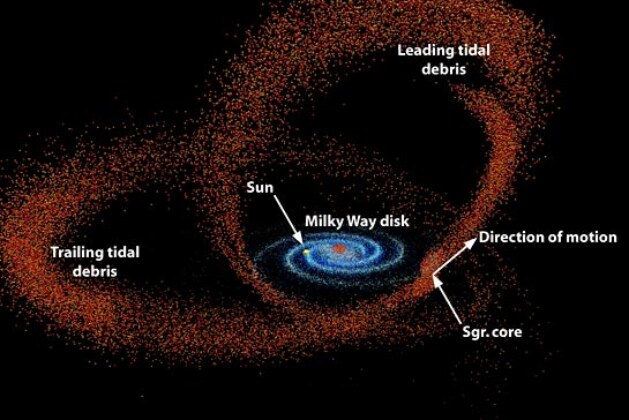Dark matter is one of the most perplexing and mysterious substances in the universe. Although we cannot see it, scientists believe it constitutes about 85% of the universe’s mass and plays a pivotal role in the structure and behavior of galaxies. In our own galaxy, the Milky Way, dark matter is essential for holding it together, shaping its formation, and influencing the movement of stars. In this article, we delve into how dark matter impacts the Milky Way, using both scientific observations and evidence to explain this invisible force’s significant role in our galaxy’s structure.
Table of Contents
Introduction
The night sky may seem like a calm and predictable canvas, but beneath its stillness lies a dynamic and complex universe—one in which the majority of matter remains hidden from our eyes. The Milky Way, our home galaxy, is no exception. While we see stars, gas clouds, and nebulae with our telescopes, what’s holding everything together is something far more elusive: dark matter.
Dark matter, though invisible, makes up roughly 85% of the mass in our galaxy, and without it, the Milky Way would not exist in the stable form we know today. From its role in galactic formation to its effect on stellar motion and the structure of our galaxy’s halo, dark matter is the unseen backbone that supports the Milky Way. But what exactly is dark matter, and why is it so crucial to our understanding of the galaxy’s structure? Let’s explore how this invisible substance impacts the Milky Way and the cosmos at large.
What Exactly Is Dark Matter?
To understand how dark matter affects the Milky Way, we first need to understand what it is. Despite being one of the most significant components of the universe, dark matter remains invisible to direct observation. It doesn’t emit, absorb, or reflect light, which is why telescopes can’t detect it in the usual ways.
The concept of dark matter was first proposed in the 1930s by Swiss astronomer Fritz Zwicky, who observed that galaxy clusters were moving faster than expected. This discrepancy suggested that an unseen mass was exerting gravitational forces, keeping galaxies from flying apart. The term “dark matter” was coined to describe this hypothetical substance. Though scientists have not yet detected dark matter directly, its presence is inferred from its gravitational effects on visible matter.
In the Milky Way, dark matter forms a massive halo that extends far beyond the visible boundaries of the galaxy. This dark matter halo is critical for the galaxy’s structure and stability, providing a gravitational anchor that keeps the stars and planets bound together.
The Galactic Halo: Dark Matter’s Influence on the Milky Way
One of the primary ways that dark matter shapes the Milky Way is through its formation of a massive galactic halo. This halo of dark matter surrounds the galaxy and extends far beyond the outermost stars we can see. Though we cannot observe the dark matter directly, its presence is inferred through its gravitational influence on visible matter, like stars, gas clouds, and even the galaxy’s rotation.
The Milky Way’s disk contains stars, gas, and dust, while the halo consists primarily of dark matter. Without this invisible mass, the galaxy would not have the necessary gravitational pull to remain intact. The dark matter halo helps stabilize the galaxy by exerting a gravitational pull on the stars and other objects in the Milky Way, keeping them from scattering into space.
Scientific Evidence:
- Observations of the Milky Way’s rotation curve—how the speed of stars changes with distance from the galaxy’s center—offer compelling evidence for dark matter. If only visible matter were present, stars in the outer regions would be expected to move more slowly, but the rotation curve of the Milky Way remains flat, indicating that an unseen mass (dark matter) is providing extra gravitational pull.
Galactic Rotation: How Dark Matter Keeps the Milky Way Together
One of the most significant pieces of evidence for the existence of dark matter comes from the study of galactic rotation curves. In a typical galaxy, stars closer to the center move faster than those on the outer edges, much like the planets in our solar system. However, when scientists measured the speeds of stars at various distances from the Milky Way’s center, they found that stars at the outer edges of the galaxy were moving at nearly the same speed as those near the center.
This was unexpected. Based on the visible mass of the galaxy, these outer stars should have been moving much more slowly and would likely be ejected from the galaxy. However, the constant speed at which they orbit indicates that there is additional, invisible mass contributing to the galaxy’s gravitational pull. That mass, as scientists now understand, is dark matter.
Scientific Evidence:
- The flat rotation curve is a direct consequence of dark matter’s influence on the galaxy’s structure. If only visible matter existed, the curve would decline at a much steeper angle, as gravitational pull would weaken with distance from the center. The presence of dark matter accounts for the unexpected flatness of the curve, as this invisible mass helps maintain the galaxy’s shape and keeps stars bound together.
Dark Matter and Stellar Orbits: Stabilizing the Milky Way
In addition to shaping the overall structure of the galaxy, dark matter also plays a crucial role in the orbits of individual stars. The Milky Way contains a dense core of stars near its center, and these stars, along with the gas and dust, form the bulge of the galaxy. Surrounding the bulge is the galactic disk, which contains most of the visible stars and nebulae.
Stars in the Milky Way orbit the center of the galaxy in a stable, predictable manner. This motion is heavily influenced by the mass of the galaxy, including both visible matter (such as stars and gas) and dark matter. While the central supermassive black hole at the heart of the Milky Way, Sagittarius A*, exerts gravitational influence, dark matter also plays a role in maintaining the stability of the galaxy’s rotation and the orbits of stars within the disk.
Scientific Evidence:
- Studies of the motions of stars near Sagittarius A*, as well as the stellar velocity dispersions in the outer regions of the galaxy, indicate that dark matter is likely distributed throughout the Milky Way’s disk. This provides additional mass and gravitational pull, stabilizing the orbits of stars and preventing them from being ejected into space.
Dark Matter Beyond the Milky Way: The Larger Cosmic Picture
While dark matter’s most significant influence is within the Milky Way, its effects extend beyond our galaxy, influencing the structure of entire galaxy clusters. Our galaxy is part of the Local Group, a collection of over 50 galaxies that are bound together by gravity. Observations of galaxy clusters, such as the Virgo Cluster, show that dark matter is a key factor in maintaining the cohesion and movement of galaxies in these groups.
The Bullet Cluster, a collision between two galaxy clusters, provides some of the strongest evidence for dark matter’s role in galaxy formation. Observations of this collision using X-ray imaging and gravitational lensing revealed that visible matter (such as hot gas) and dark matter are separated during the collision. The dark matter appears to be unaffected by the collision, indicating that it interacts only through gravity and not through electromagnetic forces.
Scientific Evidence:
- The Bullet Cluster is often cited as one of the most compelling pieces of evidence for dark matter’s existence. It provides a clear view of how dark matter behaves differently from regular matter, further supporting its role in the gravitational structure of galaxy clusters and the universe as a whole.
Conclusion: The Invisible Architect of the Milky Way
Dark matter is the unseen force that keeps the Milky Way intact. Without it, the stars, gas, and other visible matter would not have enough gravitational pull to remain bound together. Dark matter forms the massive halo that surrounds our galaxy, provides the necessary gravitational influence for the rotation curve, stabilizes stellar orbits, and shapes the Milky Way’s overall structure.
While much about dark matter remains a mystery—its true composition, how it interacts with other forces, and how it came into existence—the evidence for its presence in the Milky Way is irrefutable. As technology advances and new experiments push the boundaries of our understanding, scientists are one step closer to unraveling the secrets of dark matter, and in doing so, unlocking the deeper mysteries of the universe itself.
Read More: Lunar Gateway: A New Frontier for Humanity’s Return to the Moon and Beyond





Uma leitura bem agradável e esclarecedora.